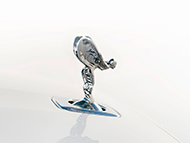From Rolls Royce Motor Press Release
Origins of an Icon
Lord Montagu of Beaulieu (1866-1929) was one of Britain’s motoring pioneers. As founder and editor of The Car Illustrated magazine, he employed an illustrator, Charles Sykes. In 1909, Lord Montagu commissioned Sykes (who was also a sculptor) to create a mascot for his Rolls-Royce Silver Ghost. Sykes produced a bronze statue of a young woman in fluttering robes, which he named the ‘Whisper’.
Soon, other owners were having their own ornaments made, much to the displeasure of Rolls‑Royce General Managing Director, Claude Johnson. In 1911, Johnson instructed Sykes to design an ‘official’ mascot to protect the company’s products from these ‘unsightly’ additions. The ever-practical Sykes subtly reinterpreted ‘The Whisper’ and created what became known as the Spirit of Ecstasy.
The design was registered as the company’s intellectual property in 1911 and became both a defining feature of the Rolls-Royce brand and one of the most famous, iconic and desirable emblems in the world. Originally a statuesque seven inches (c. 18cm) tall, the Spirit of Ecstasy today stands a more petite three ¾ inches (9.5cm) high.
In the 1970s, some countries tried to ban the mascot on safety grounds. In Switzerland, for example, customers weren’t allowed to display her at all, and on receiving their cars found her languishing in the glove compartment. Rolls-Royce’s typically elegant and ingenious solution was to mount the mascot on a spring-loaded base, allowing her to sink into the radiator out of harm’s way at the merest touch. This retraction mechanism has evolved into a smooth, graceful movement known as ‘the rise’ and is a standard feature on every Rolls-Royce motor car hand-built at Goodwood.
Spirit of Innovation
Until 1999, the figurines were made by ‘lost wax’ casting, which dates back over 5,000 years. Amazingly, Charles Sykes himself, assisted by his daughter Josephine, personally cast, inscribed and finished every Spirit of Ecstasy right up until 1939.
In preparation for the launch of Phantom in 2003, BMW Group rejuvenated the Spirit of Ecstasy by introducing the modern investment casting process, working with a specialist company in Southampton, England.
The first step was to digitally ‘map’ the original Spirit of Ecstasy, manipulating and enhancing individual details to create a perfect three-dimensional computerised image. To ensure even the finest details were precisely replicated, the injection mould was formed by skilled craftsmen using cutters measuring just 0.2mm in size. This cast tool was used to produce a highly accurate wax model of the figurine, which was then coated in ceramic. After this coating had dried, the wax was melted away, leaving a perfect mould from which the new cast would be taken.
Each figurine is made by filling the mould with molten stainless steel, at a temperature of 1600°C. Once the steel has cooled, the mould is opened to reveal the Spirit of Ecstasy in all her glory. The final transformation takes place in the Finishing department, using a process called peening. The casting is blasted by millions of stainless steel balls just 17 thousandths of an inch (0.04mm) in diameter, which help to polish the surface without being abrasive. After machining, a final mirror polish and stringent quality assurance checks, the completed figurine takes her rightful place above the iconic Rolls-Royce grille.
Sykes' original the ‘Whisper’ and other Spirit of Ecstasy figurines are on permanent display at the National Motor Museum, Beaulieu.
Celebrating in Style
In January 2011, the company launched The Spirit of Ecstasy Centenary Collection to mark its famous mascot's 100th anniversary. Limited to just 100 Bespoke Phantom models, the collection featured exclusive body colours, leather combinations, wood veneers and interior details. All featured a specially commissioned Spirit of Ecstasy in solid silver, with six hallmarks (including two designed specifically for Rolls-Royce Motor Cars) on a black-gold plated illuminated base. Rolls-Royce also commissioned leading British portrait and fashion photographer Rankin to produce a series of 100 images inspired by the figurine.
The MUSE of the Marque
The Spirit of Ecstasy was created by a highly respected artist and illustrator Charles Robinson Sykes (1875-1950). Many of his wonderful designs for advertisements and magazine covers are conserved in London’s world-famous Victoria & Albert Museum (V&A). That foundational link with the world of fine art lives on, with the Spirit of Ecstasy serving as a muse and source of inspiration for the Rolls-Royce brand.
In 2016, innovative Belgian designer Charles Kaisin created an installation comprising 2,500 miniature origami pieces, all made from silver paper folded into the shape of the Spirit of Ecstasy; pieced together, they recalled the iconic figurine.
The marque’s longstanding relationship with the art community has been further strengthened through MUSE, The Rolls‑Royce Art Programme. As part of this unique initiative, the biennial Spirit of Ecstasy Challenge invites established and emerging creative practitioners to re-imagine her distinctive form in a material and manner of their choosing.
Looking into the Future
In 2020, the Spirit of Ecstasy took on a new life and appearance as part of a wider update of the Rolls-Royce brand identity. Known as The Expression, she appears ethereal and regal, yet with a highly contemporary, technological edge that reflects the company’s vision as a modern House of Luxury.
